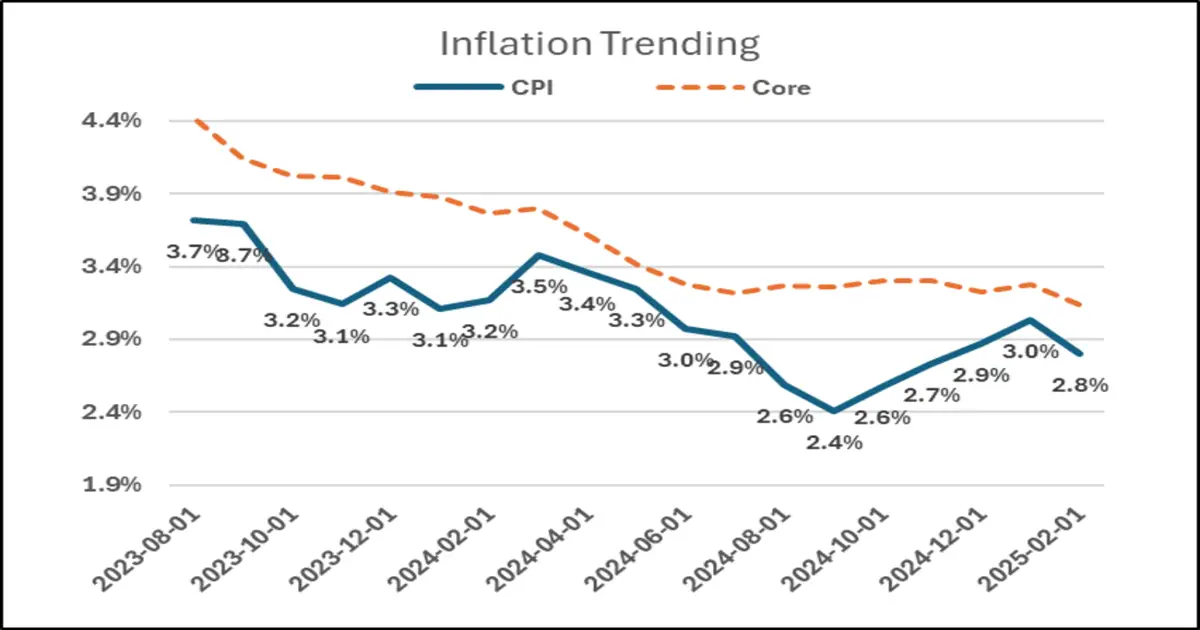The latest economic data provides a mixed outlook for the real estate market, with inflation showing signs of easing, interest rates stabilizing, and mortgage rates fluctuating near recent highs. While this suggests some clarity for buyers and sellers, broader economic and policy factors could shape market conditions in the months ahead.
Inflation Eases, but Fed’s 2% Target Remains Distant
February’s inflation data showed a slight cooling, with overall CPI declining from 3.0% to 2.8% and core CPI (which excludes food and energy) falling from 3.3% to 3.0%. This marks the first decline in four months, offering some relief after persistent inflationary pressures. However, many economists remain skeptical that inflation will return to the Fed’s 2% target anytime soon.
Meanwhile, retail sales increased just 3.1% year-over-year—barely keeping pace with inflation—indicating that real consumer spending has been largely stagnant. This suggests economic momentum may be slowing, a factor that could support future rate cuts but also raises concerns about overall growth.
Mortgage Rates in a Holding Pattern—For Now
After months of volatility, mortgage rates have stabilized, at least for the short term. Over the past three months, rates initially climbed before pulling back and settling into a narrow range. The big question remains: is this a period of sustained stability, or just a pause before another breakout?
Competing economic factors are creating a tug-of-war in rate expectations. Weak retail sales, soft job creation, and falling consumer sentiment suggest rates should move lower. On the other hand, rising industrial production, increasing new home construction, and the need for significant government borrowing to cover federal debt could push rates higher. The bond market is also closely watching global interest rate trends, with rising rates in Germany and Japan adding external pressure.
For homebuyers, this uncertainty means that while rates are no longer spiking, they are still elevated, making affordability a continued challenge. For sellers, the key remains pricing homes strategically to attract buyers who are still sensitive to higher borrowing costs.
Fed Outlook: Rate Cuts Likely, but Not Immediately
The Federal Reserve is not expected to make any immediate policy changes at its March meeting, but all eyes will be on its updated economic projections. Current market pricing suggests two 25-basis-point cuts over the course of 2025, with the Fed Funds rate potentially declining to 3.5% by late 2026.
This would mark a gradual return to lower rates but would not necessarily result in rapid relief for mortgage borrowers. In the absence of another rare yield curve inversion, a 3.5% Fed Funds rate would likely set a floor for long-term interest rates, including the 10-year Treasury and mortgage pricing.
Are Recession Risks Increasing?
- Tighter Credit Conditions: The Fed’s ongoing fight against inflation means that credit remains expensive, which could curb business investment and consumer spending.
- Federal Debt and Bond Market Strain: The government is issuing significant amounts of debt, which could lead to rising borrowing costs and financial market volatility.
- Global Trade and Tariffs: The impact of rising tariffs, particularly on imports from China and the EU, could increase costs for businesses and consumers, weighing on economic growth.
If economic momentum weakens further, the Fed may be forced to cut rates more aggressively than currently anticipated. However, if inflation remains stubbornly above target, the central bank may hold off on rate cuts, increasing the risk of a policy-driven slowdown.

